The Middle Funnel Is Where the Money Is for AEO and AI Search
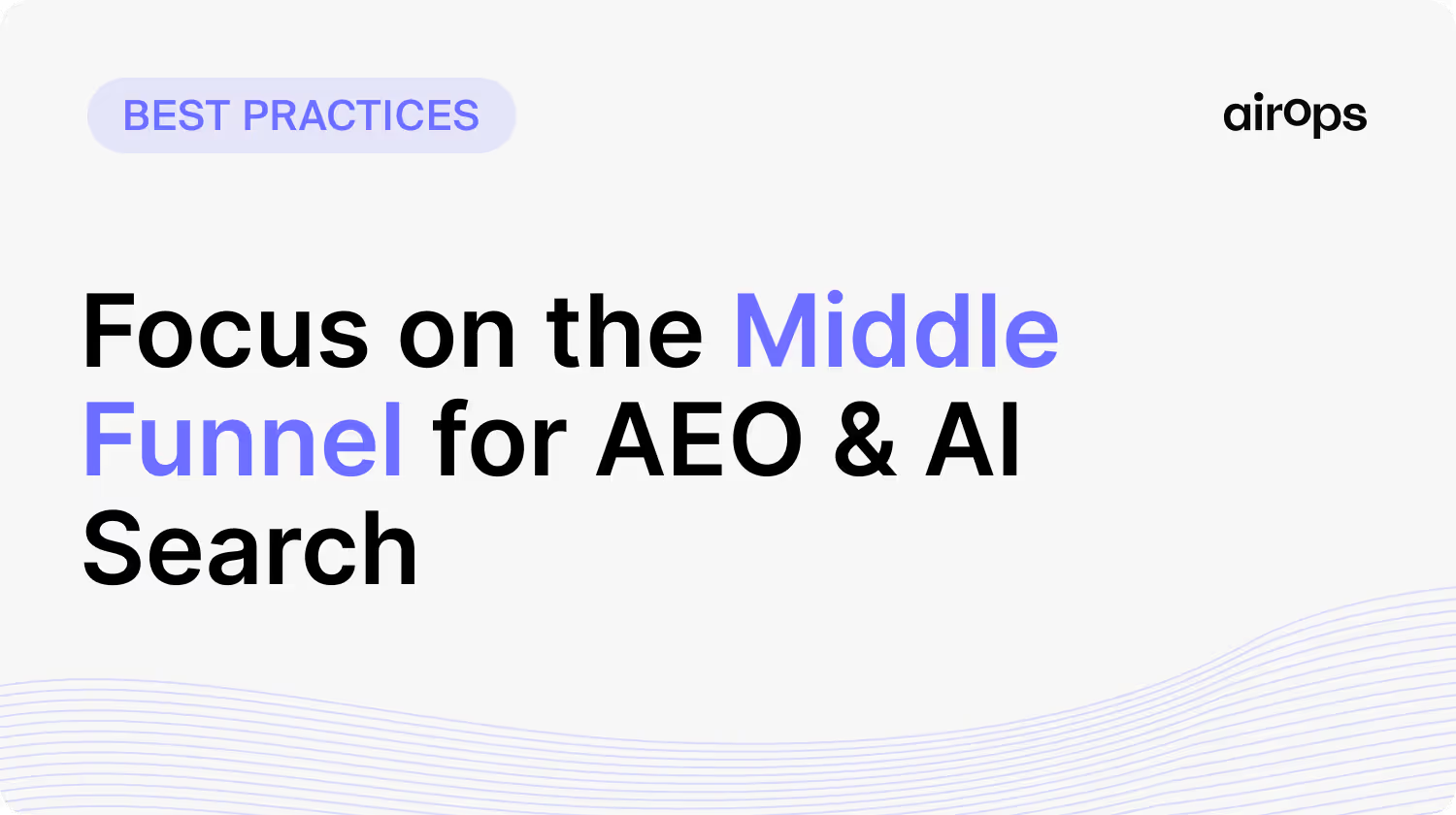
AI search is reshaping the customer journey and MOFU content is where revenue gets made.
→ The top of the funnel is collapsing.
AI Overviews, chatbots, and answer engines are resolving basic queries before users ever reach your site. You’re losing visibility.
→ The middle is where the buyer shows up.
High-intent users still click, compare, and decide. MOFU content meets them with trust signals, proof, and answers that drive real pipeline.
→ Build content that convinces, not just attracts.
Mid-funnel pages—like comparison guides, expert explainers, and case studies—close the gap between attention and action.
→ AEO is your strategic edge.
To stay visible, content must be structured for extraction, rich with expertise, and designed for agent citation and not just ranking.
→ Win the middle or lose the deal.
With traffic compression, influence happens between the scroll and the shortlist. Build for that moment.
Let’s be clear: your traffic isn’t dropping because people stopped searching. It’s dropping because answer engines are cutting you out of the top of funnel and informational queries.
ChatGPT, Perplexity, Google’s AI Overviews are doing exactly what they were built to do: intercept low-intent queries and resolve them instantly.
Here’s the twist most marketers are missing: you’re not losing buyers. You’re losing browsers. It’s happening across every search engine, including AEO and traditional search.
How do you optimize then? What do you do?
The data backs up what feels true:: A 2025 SEMrush study of 10M+ keywords found that Google is deploying AI Overviews primarily on queries that are difficult to monetize and deliberately avoiding disruption to its ad revenue model.
High-CPC, high-intent queries? Still largely untouched.
In fact, 95% of keywords triggering AI Overviews either have no ads or extremely low commercial value, while commercially valuable keywords with higher CPCs are intact.
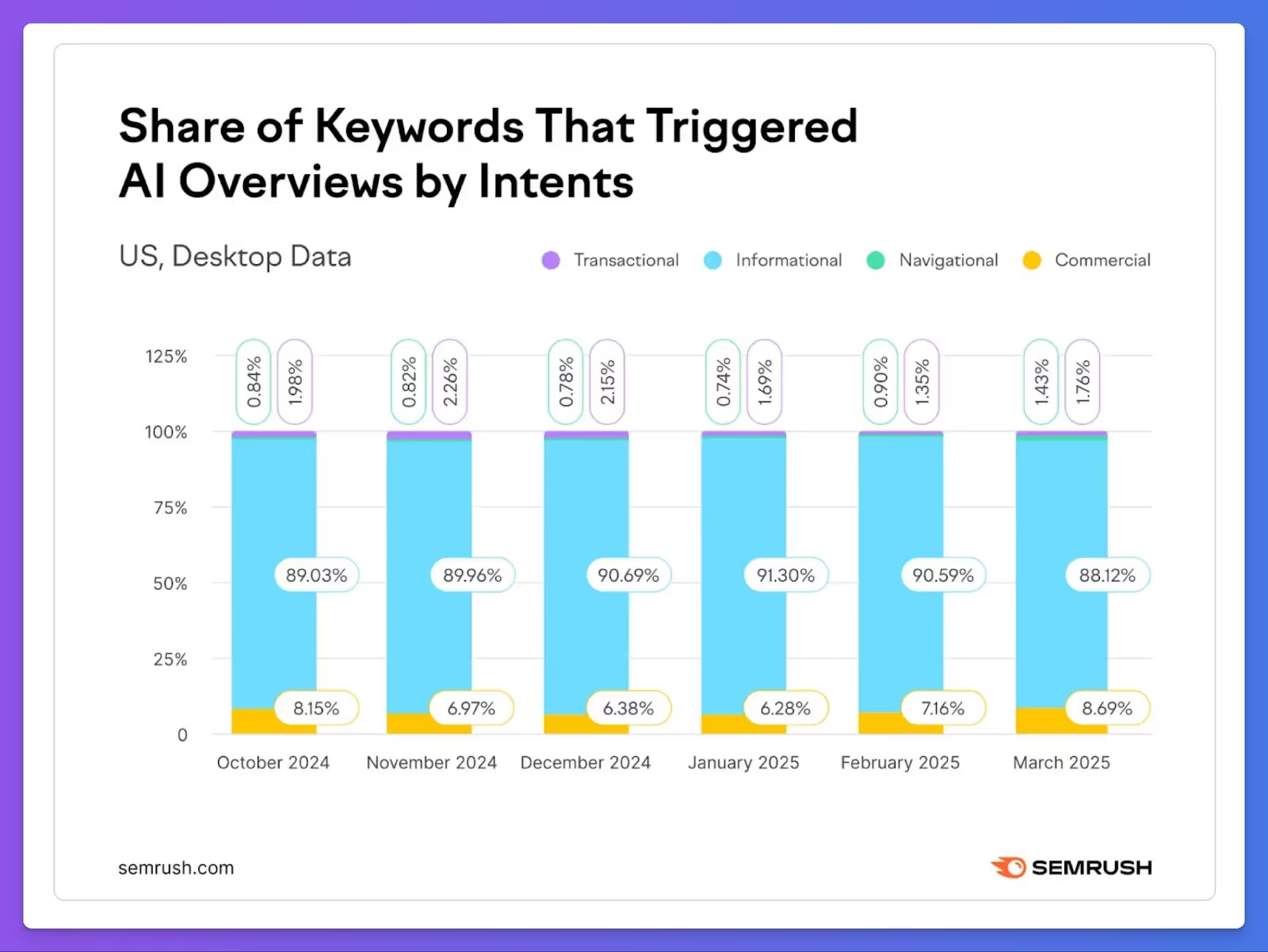
Only 8.69% of AI Overview queries are commercial, with just 1.76% being transactional. The most valuable, decision-ready traffic is still flowing to your site.
You’re Getting Fewer Visits, But With Higher Intent. That’s Traffic Compression.
What's left are people with real intent: folks comparing solutions, digging into complexity, asking smarter questions.
Translation: AI is doing the filtering for you. It’s scraping away the fluff and what’s left is the good stuff.
The people still making it to your site? They have real intent. They’re actively comparing, evaluating, and deciding. Your site traffic has compressed and is now focused on the middle and bottom funnels.
That’s middle funnel territory, with buyers focused on the consideration stage. And that's exactly where smart content teams are doubling down.
How do you take advantage of that for AEO and AI search?
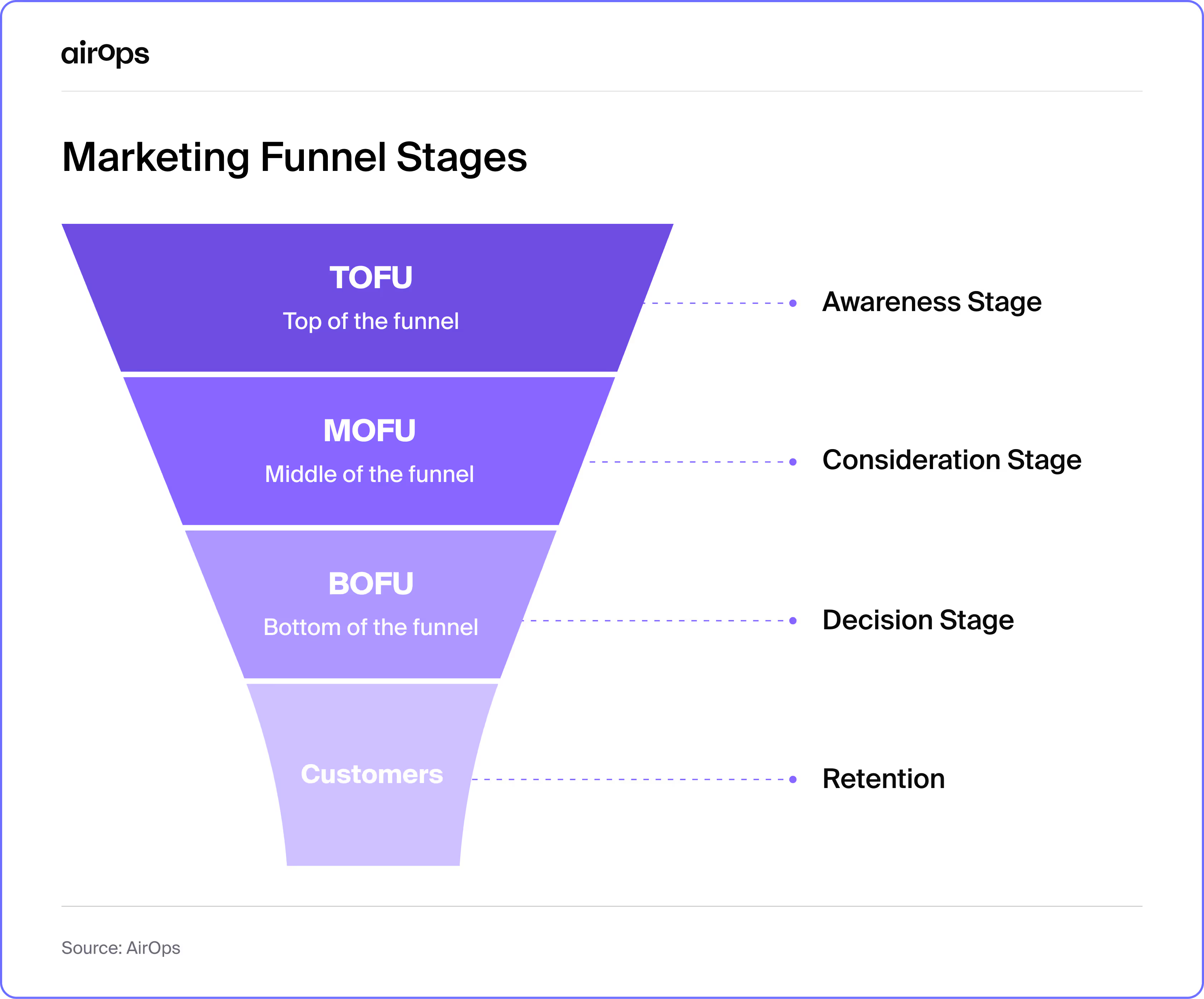
The MOFU Opportunity: Where Pipeline Gets Built in AEO & AI Search
While most marketers are still wringing their hands about vanishing top-funnel traffic, the smartest teams are quietly building something better: a content engine that converts.
MOFU content isn’t a blog post hoping for clicks. It’s revenue infrastructure.
Middle funnel content does what top-funnel content never could:
- Builds trust, not just awareness
- Handles objections, not just interest
- Demonstrates authority, not just presence
- Sends signals to AI systems and human buyers alike: this brand knows what it’s doing
You do this by showcasing authority, achievements, case studies, and confidence.
That’s exactly how Lightspeed — a global commerce platform — saw a 37% increase in content conversion rates after restructuring its strategy around enriched, mid-funnel content with AirOps. Within 30 days, they saw measurable pipeline impact from content that convinced buyers.
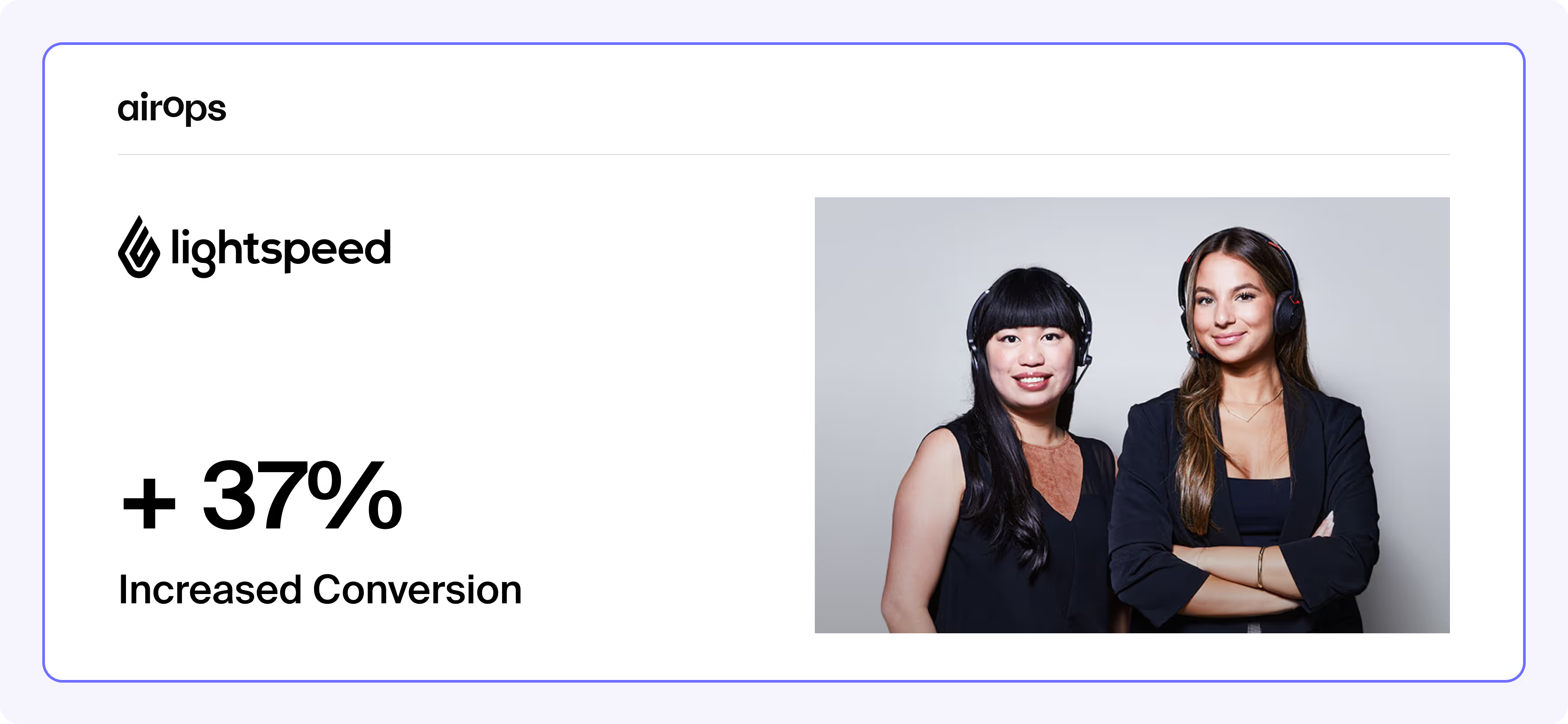
The content types that win in this new landscape aren't your typical blog posts:
High-performing MOFU content includes:
- Comparison pages that address specific vendor evaluation criteria
- Expert POV explainers that demonstrate thought leadership
- Decision-stage FAQs that preemptively handle objections
- Proof-driven case studies with measurable outcomes
- Process-oriented guides ("How to evaluate [category]")
- Risk mitigation content that addresses "what could go wrong"
This is the content that closes the gap between consideration and conversion. That shift in user behavior is exactly why your content team can’t keep measuring success the same way. It’s time to move from traffic metrics to revenue mechanics.
Move From Traffic Volume to Revenue Velocity
If your content strategy is still built around pageviews and lead volume, you’re playing the wrong game — and the smartest buyers are slipping past you.
Modern AI search teams aren’t traffic generators. They’re growth operators.
That shift in mindset changes everything.
MOFU content isn’t built to cast a wide net. It’s built to:
- Anticipate objections
- Speak directly to business pain
- Position your solution with credibility and authority
- Feature the voices and proof buyers actually trust
You’re not trying to attract more leads. You’re building content that filters, qualifies, and converts.
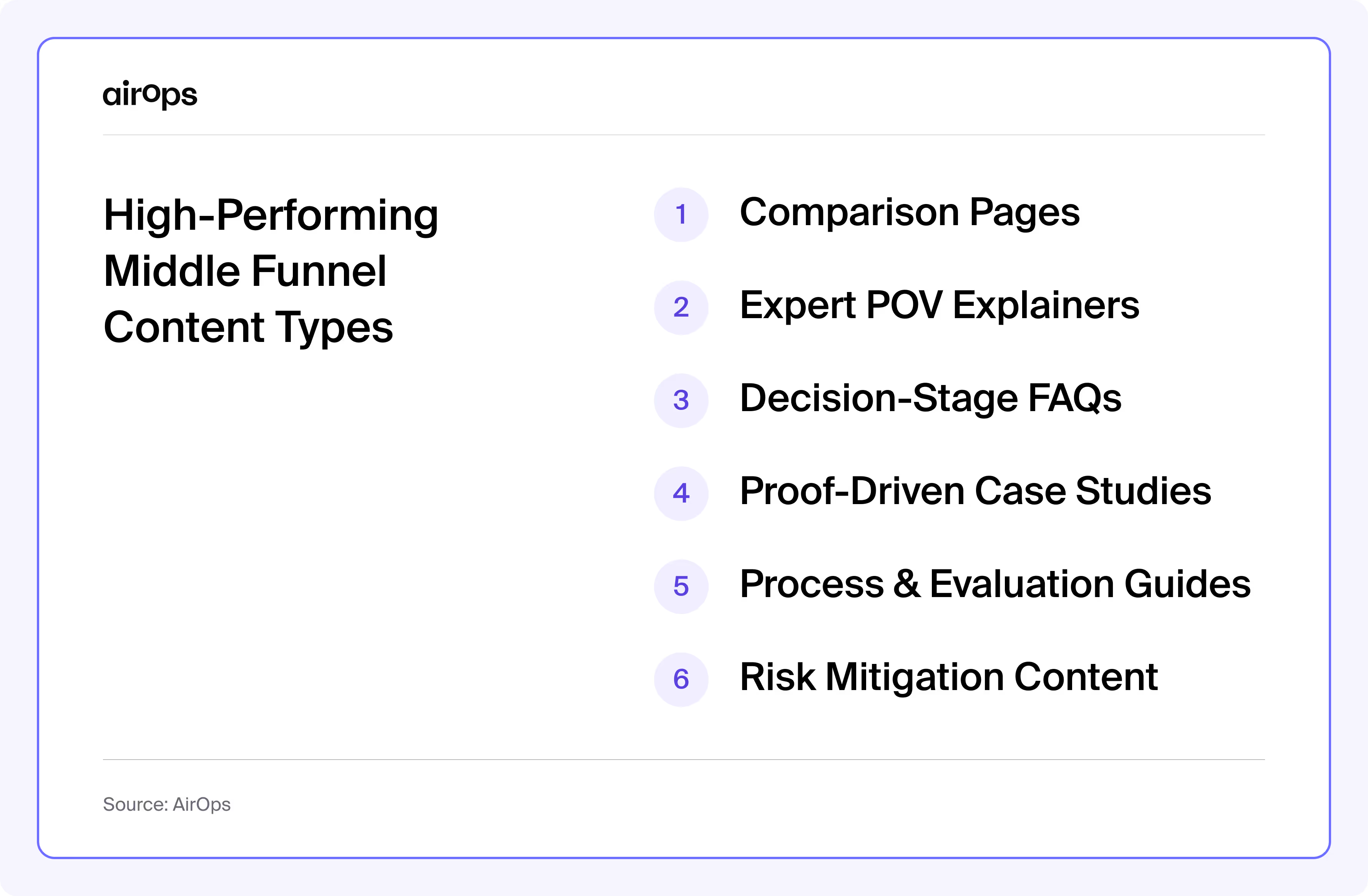
The revenue mindset means:
- Prioritizing pipeline velocity over vanity metrics
- Solving for multi-stakeholder decisions, not just individual pain
- Creating assets that accelerate sales cycles
- Building trust that survives the handoff to sales
Top-of-funnel content might catch attention. Mid-funnel content earns confidence and puts you in the conversation. When prospects hit the MOFU stage, they already know they have a problem.
Your content’s job is to show them what’s next and prove you’re the right guide.
Making Content Ready for AEO & AI Search
Unlike traditional SEO, which fights for position on a blue-link SERP, Answer Engine Optimization (AEO) is about getting quoted and earning a spot inside AI-generated answers.
The rules are different. The bar is higher.
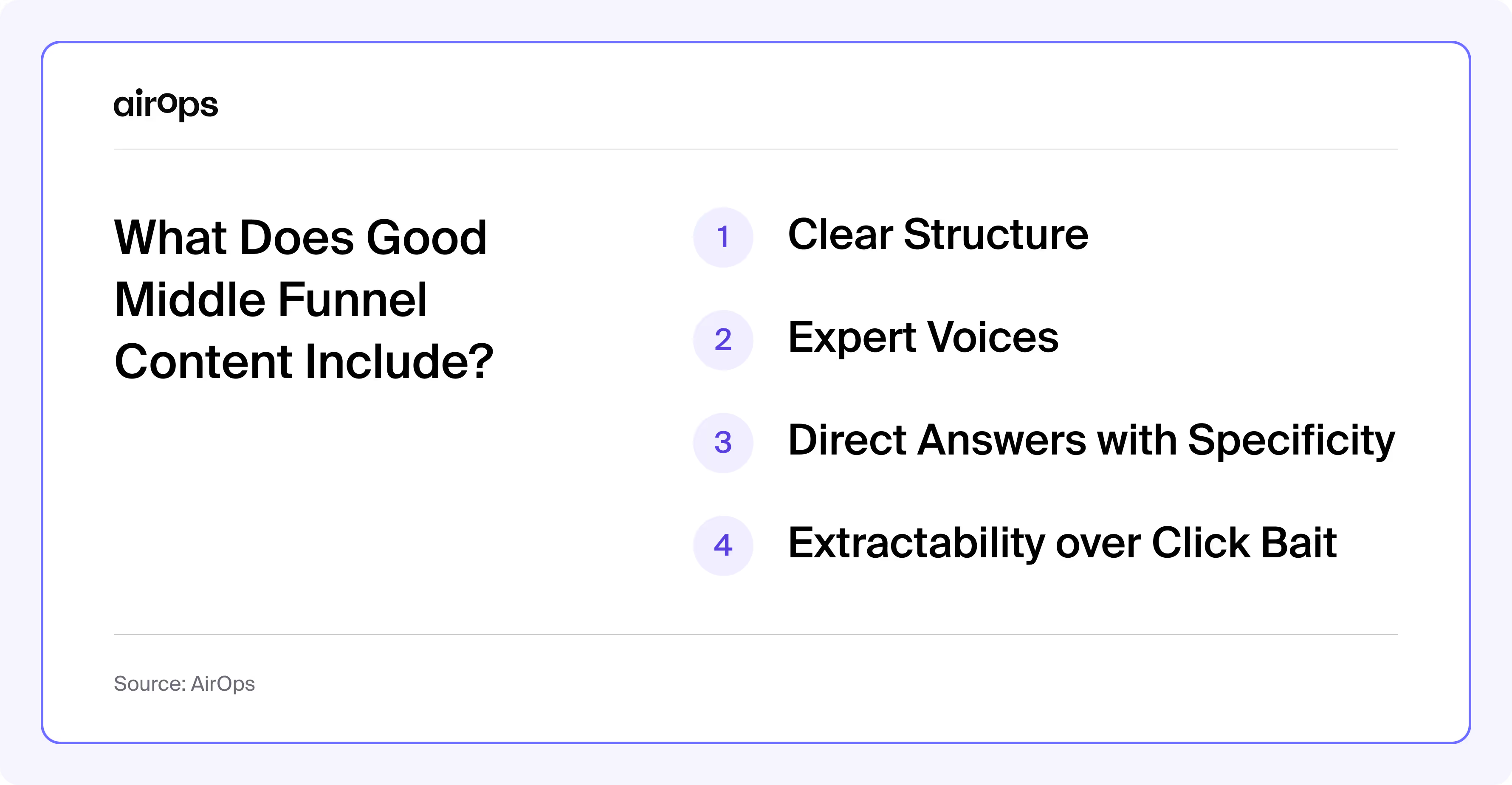
To win in AI search environments, your middle of funnel content needs:
- Clear structure: Headlines, subheads, and summaries that AI can scan and lift
- Expert voices and citations: Authority signals AI systems recognize and prioritize
- Direct answers: Specific, in-depth responses to high-intent, mid-funnel questions
- Extractability over clickbait: Content that serves both AI engines and human readers
And don’t overlook the technical layer — because structure isn’t just visual, it’s architectural:
- Schema markup on key content types
- Fast-loading pages optimized for AI crawlers
Clean HTML hierarchy (headers, lists, and answers in plain language)
What Metrics Matter Now?
Pageviews won’t tell you if your content is working. Neither will time-on-site.
In the compressed funnel, those vanity metrics are relics from a world that no longer exists.
Mid-funnel content isn’t built for clicks (instead it’s confidence and trust), but that means its results are often delayed and non-linear, making attribution more complex than bottom-funnel tactics like direct signups or demo calls.
You won’t measure MOFU success in likes or leads. You’ll see it in faster deal cycles, stronger intent signals, and AI systems that start quoting you instead of your competitors.
But to get there, you need a new playbook for measurement. This is a playbook that reflects how modern buyers actually make decisions and how AI agents influence those decisions along the way.
Start tracking these AI-era metrics:
Traditional MOFU metrics:
- Click-to-conversion rate on MOFU pages
- Time-on-page + next action (what happens after they read?)
- Mid-funnel influenced pipeline (revenue attribution)
New AI-Search metrics for middle funnel:
- Agent citation frequency (how often AI tools quote your content)
- Source authority score (quality of sites linking to you)
- Question coverage ratio (percentage of relevant queries you can answer)
- Competitive citation share (your mentions vs. competitors)
- AI-sourced pipeline contribution (revenue attributed to sessions or leads that originated from AI-generated content or summaries)
Set realistic measurement timeframes of 3-6 months, as mid-funnel results require time to manifest in pipeline and revenue metrics.
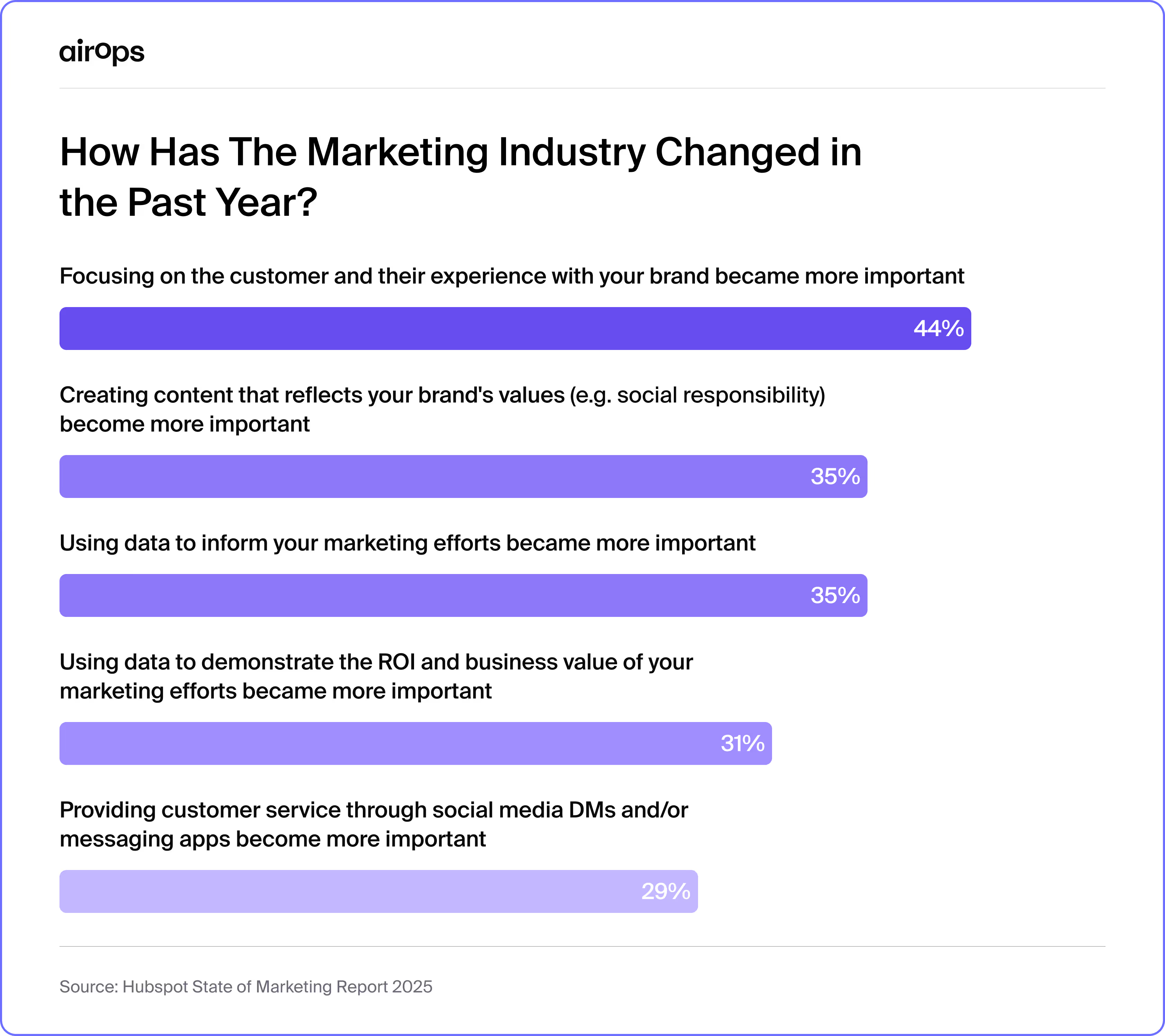
The Resource Reality Check for Smart Teams
Before you create another piece of content, audit what you already have.
Most teams are sitting on assets that could drive pipeline but aren’t built to perform in a in a compressed environment.
Ask yourself:
- Does this content answer the right questions — or just obvious ones?
- Is it citation-worthy? (clear, factual, well-structured, sourced)
- Does it lead somewhere? (conversion pathways, not just passive reads)
- Are trusted voices present? (experts, stats, credibility cues)
Middle funnel content doesn’t live in isolation. Where can you repurpose it to address your whole growth engine?
- Repurpose MOFU insights for social proof content
- Create podcast/video versions for different consumption preferences
- Build email nurture sequences around your strongest MOFU pieces
Creating effective MOFU content isn't a side project. If you're starting with MoFu content, aim for a minimum of 1-2 pieces per month, scaling to 3-4 pieces monthly once you’re established
Most brands are still focused exclusively on Google rankings and traditional SERP visibility, creating a first-mover advantage for businesses investing in AEO now.
Smart teams are already monitoring:
- Tracking which sources dominate AI answers in their space
- Analyzing content types with the highest citation rates
- Mapping their competitive citation share across key categories
Grab the first-mover advantage with this shift in search.
The CMO Checklist for Winning the Middle Funnel
Rebalance your budget before AI eats it alive.
If most of your content spend is still going to top-of-funnel, you're not building pipeline. You're training language models. Shift your investment toward mid-funnel content that drives decisions and starts real sales conversations.
Start thinking like RevOps, not just Marketing.
Content should not stop at lead gen. It should accelerate deals. Bring SEO, content, and revenue teams into the same room. Build assets that handle objections, support multi-stakeholder buying, and move opportunities forward.
Move before your competitors realize the rules have changed.
Most teams are still chasing blue links and optimizing for a vanishing SERP. You have a 6 to 12 month window to own the high-intent queries inside AI-powered search. First movers will define the next category leaders.
Redefine performance around influence, not volume.
Pageviews don’t close deals. Start tracking metrics that map to revenue. Measure agent citations, AI-sourced pipeline, extractability, and how fast leads move from click to conversion.
Operationalize MOFU content instead of treating it like an experiment.
Middle-of-funnel content is no longer optional. It needs a process. Start with two high-quality assets per month. Use formats like comparison pages, expert POVs, case studies, or competitor alternatives. Build to a weekly cadence with real ownership behind it.
Set executive expectations now.
MOFU content takes time to show results. Expect a lag of three to six months between publishing and pipeline lift. But when it hits, it compounds. Deals close faster. Confidence goes up. Buyers stay with you longer.
Your Funnel Is Feeding Everyone But You
If 80 percent of your budget is still going to top-funnel, you’re not building pipeline. You’re feeding the machine that’s replacing you.
Gartner predicts that "by 2026, traditional search engine volume will drop 25%, with search marketing losing market share to AI chatbots and other virtual agents".
While predictions aren't certainties, the directional trend is clear.
The middle is where the money is now.
Teams need to rebalance content strategies toward influence and conversions. Clicks don’t convert. Influence does. If your content isn’t helping real people make confident decisions, it’s just background noise in a world of infinite content.
Lean Into the Middle or Lose the Deal
The best teams are optimizing for trust, conversion, and agent credibility.
Middle-of-funnel content has become the last untouched space where humans still click and make decisions. It's where qualified prospects evaluate solutions, compare alternatives, and build the confidence to move forward.
This is where you earn the citation, the shortlist, the sales conversation.
While your competitors are still stuck chasing rankings in a shrinking SERP, you can be building the infrastructure that converts high-intent visitors into pipeline velocity.
This isn’t a content crisis. It’s a strategic shift. And it rewards the teams who move first.
Now’s the time to rewire your strategy, double down on decision-stage content, and win the compressed funnel.
Ready to make your content MOFU- and AEO-ready? AirOps is the only AI search platform that helps teams visualize, act on, and measure their content’s influence, so they stay visible and cited where clicks alone can’t reach.
Book your call today.
Win AI Search.
Increase brand visibility across AI search and Google with the only platform taking you from insights to action.
Get the latest on AI content & marketing
Get the latest in growth and AI workflows delivered to your inbox each week




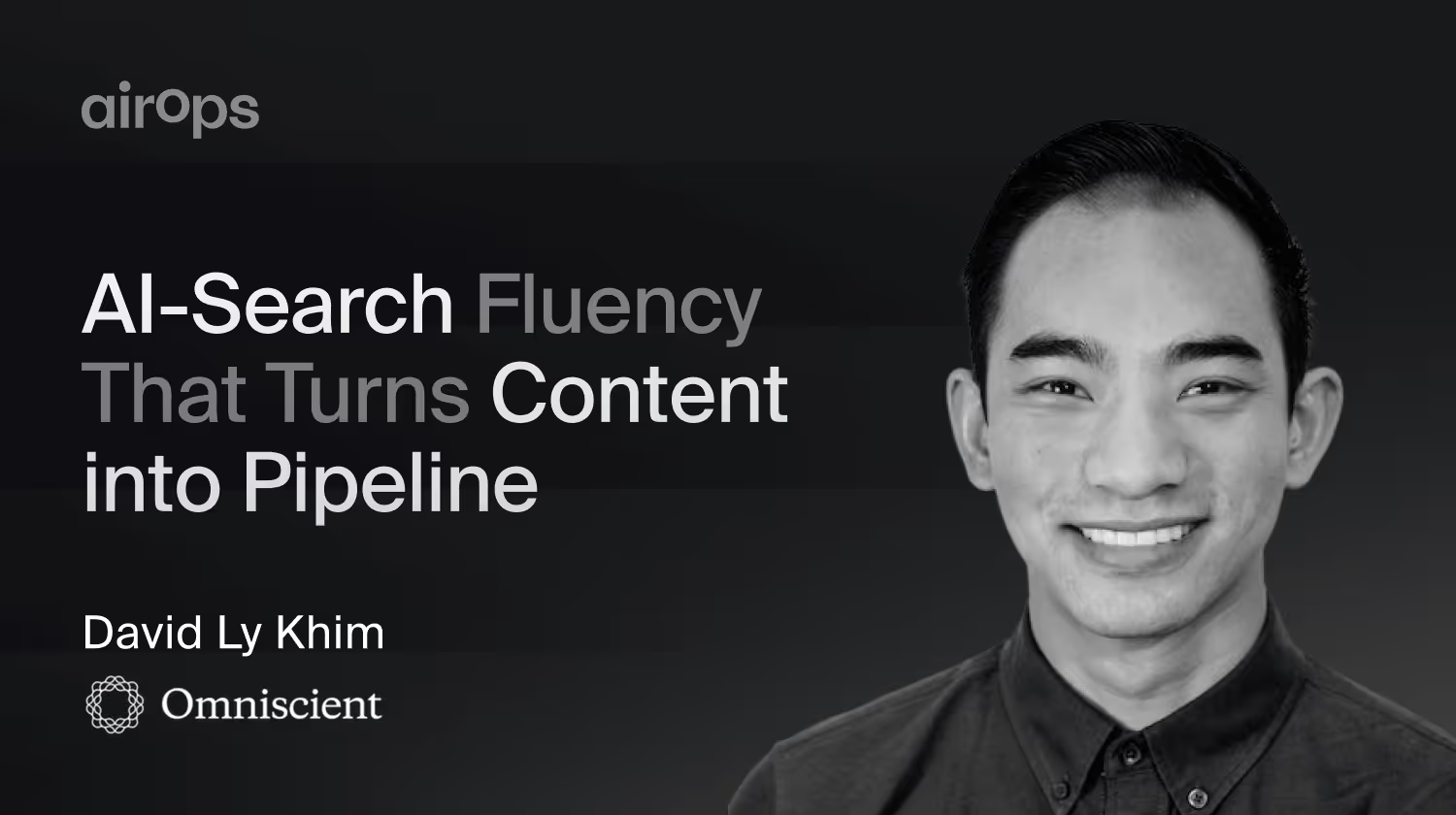

.avif)
